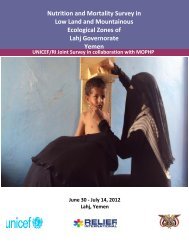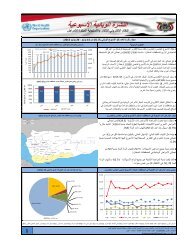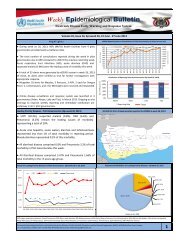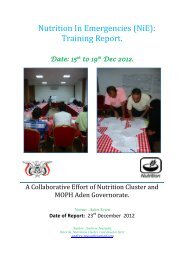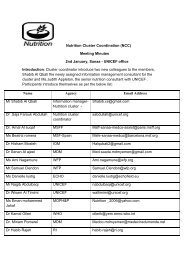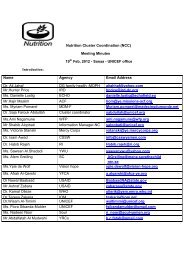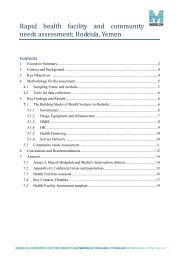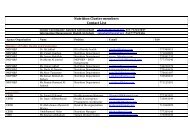Abyan Assessment Report - Internal Displacement Monitoring Centre
Abyan Assessment Report - Internal Displacement Monitoring Centre
Abyan Assessment Report - Internal Displacement Monitoring Centre
- No tags were found...
Create successful ePaper yourself
Turn your PDF publications into a flip-book with our unique Google optimized e-Paper software.
4. Targeting: The community is asked to identify the main groups within thecommunity that are most affected by the identified top three priorities2.2 Sample size and site selectionUsing purposive sampling (Oct 2011/ACAPS), a sample size of 14 localities was agreed betweenOCHA and the clusters in Aden. In selecting the 14 locations the following criteria were used:It should represent the different population groups (IDPs; New/Old, Returnees, andNon-displaced),It should represent the Bedouins, marginalized and those not originally from <strong>Abyan</strong>.It should be either rural or urban areas,Different types of topographic settings should be represented, such as the coast, valleys,and mountains,It should represent different income/livelihood sources; agriculture, fishery, livestock,small/micro enterprise, and government employees.Due to security issues, two of the locations were not assessed. Table 1 provides a breakdown ofthe characteristics of each locality.2.3 <strong>Assessment</strong> TeamsThree teams that include UN agencies (UNHCR, UNICEF, WHO, IOM), INGOs (Save the Children,Intersos, DRC, Oxfam) and national NGOs (SHS and CSSW) carried out the field assessment.Each team was composed of 4 members of whom one is the team leader and the other asecurity focal point. The criteria for membership into a team were:1. Cluster representation with at least a representative from the protection cluster.2. Gender representation in each team to make sure a female member of the team to interviewwomen in the communities.2.4 TrainingPrior to the assessment, two training sessions were conducted by OCHA in relation to MIRA(methodology and practical procedures to conduct and ask questions). To pre-test the MIRAquestionnaires (attached separately) and assess the performance of the teams, thequestionnaires were piloted in three schools that harboured IDPs.Pre-field activities included the production of a Training Manual for Community Level<strong>Assessment</strong> teams, a Descriptive Analysis Plan for coding, area and community mapping, andholding a workshop for participating team members. Training was also conducted on mines andunexploded ordinances (UXOs) awareness considering that the assessment was to be carriedout in areas with mines and bobby traps.7
2.6 <strong>Report</strong> StructureThe assessment report includes situation overview, a summary analysis by problem area/sectorand an analysis of the underlying causes contributing to the identified problems. It alsoexamines and ranks the first, second and third priority problems in the assessed locations andthe most affected groups within the community. It compares the results of the generalized KeyInformant (KI) interviews (Module II) with the First Level Analysis (FLA) (Module III) forsimilarities and discrepancies. The analysis reveals most serious problem areas and priorityareas for further, in-depth assessment and for priority interventions.The report is to be further enhanced with context level analysis by clusters and eventually givento cluster experts for designing/ updating ongoing specific sectoral response plan includedunder <strong>Abyan</strong> and South Response Plan and in line with the policy recommendations.Frequency distribution of the problem areas identified as serious problems in each of assessedlocations at the KI level is shown in Annex A to highlight the variations within and betweenlocations.The underlying causes of the problem areas identified as serious problems in each of theassessed locations at KI level is also shown in Annex B. This report does not contain anySecondary Data Review (SDR) in its current version.While preparing the report and as part of the ongoing discussion with Nutrition cluster; it wasrealized that including nutrition cluster inputs for the IF was difficult. MIRA is designed oncollecting information from the community based level; whereas, nutrition needs areinformation from the household level. Therefore, a section will be inserted at the end of thereport for nutrition findings based on SMART tool. The other challenge was projecting findingsof different governorates on <strong>Abyan</strong>. Nutrition clusters conducted SMART survey in 2012 in thefollowing governorates in partnership with MoPHP. The governorates targeted in 2012 were:Hodeidah, Taiz, Hajja, Rayma and Lahj.Based on discussion with nutrition cluster, the agreement was to project the findings of Lahjcostal area on <strong>Abyan</strong>. However, the discussion is ongoing with nutrition cluster on designing setof questions to be included in the future assessments.9
ReturneesNewOldHost Com.Host NonRural AreaUrban AreaBedouinsMarginalizedTable 1: Description of MIRA assessed locations#<strong>Assessment</strong> Place /AreaIDP`s Host Assessed GroupsNon<strong>Abyan</strong>Type ofsetting*Major EconomicActivities **C V M A G.E L F SME1 Ja`ar City / Allohom • • • • • • • • •2 Ja`ar City / Qaderallah • • • • • • • •3 Al-Kud • • • • • • •4 Al-Musemir • • • • • • •5 Amodiah • • • • • • •6 Al-jool • • • • • • •7 Al-Rowah • • • • • • •8 Al-Mehraq • • • • • • • •9 Batis • • • • • • • • •10 Al-Husn • • • • • • •11 Al-Makhzan • • • • • • •12 Al-Dirjaj • • • • • • •13 Ubar Othman • • • • • • •14 Zinjibar City /Limited • • • • • • • •10
8. Most of the contributing factors relating to a problem being described as a “seriousproblem” attributed it to availability, followed by limited economic resources,physical/logistic constraints and security constraints. % of each item would be veryinteresting here as well.9. The top three most “serious problems” as identified by both Key Informants (KI) andFirst level Analysis (FLA) are water, food and health care with all groups equally affected.10. There is a high similarity between the priorities of the individual locations at the KIs leveland those at the FLA with water having the highest frequency as the first priority.11. Although Protection was not highlighted as one of the top three priorities, however, itwas more pronounced in urban areas with three of the urban locations (Qaderallah,Allohom & Al-Mehraq) citing it as a priority problem compared to only one rural location(Al-Makhzan) citing it as a priority problem. In the urban areas, Qaderallah cited it as thefirst priority problem and Allohom & Al-Mehraq cited it as third priority problem. In Al-Makhzan, protection was cited as a third priority problem.12. Education was also not cited as a first priority problem in any of the locations. However,it was cited as a second priority in Al-Makhzan and Allohom with boys & girls being mostaffected. As a third priority problem, it was also cited by Al-Rowah 3 .13.Electricity or the lack of it was mentioned as a priority problem in two rural locations (Al-Musemir and Amodiah) and Zinjibar city an urban location. Al-Musemir cited it as a firstpriority problem, and as a second priority in Amodiah. Zinjibar city on the other hand cited it asboth second and third priorities 4 . 3.0 Situation OverviewOn 12 May Yemeni Army with tribes allied with government authorities launched a largescaleoffensive operation against Ansar al-Sharia aiming to push Pro-Al Qaida militias out ofthe cities. In mid-June, the Defence Ministry announced that the militants had been drivenout of the governorate, including the cities of Zinjibar and Ja'ar, where the militants hadpractice control over a year during the political unrest.The fierce fighting, which involve sometimes strikes, has led to a severe deterioration of thehumanitarian situation in <strong>Abyan</strong> governorate. It hampered the ability of the internationalhumanitarian community and among them ICRC to deliver urgent relief aids 5 .As a direct impact of the military operation in <strong>Abyan</strong>, the humanitarian situationdeteriorated more as the delivery of basic social services disrupted more. The vulnerabilityof different groups exacerbated increased. Limited presence of law enforcement forces andsometimes the lack of law enforcement limit if not prevent access of humanitarianorganizations and limited its ability to work. To overcome the limited humanitarian access,the delivery modality adopted was through implementing partners or through contractors.3 These areas faces sever fighting.4 Same as above.5 HCT released a message in May 2012 requesting for respecting IHL and IHRL and allow access to affected people.12
Moreover, Most of the contributing factors relating to a problem being described as a“serious problem” in modules two and three attributed it to availability and the militaryoperations as well as destruction of the infrastructure and security situation can justify this.The second factor is limited economic resources. This factor is in direct relation to the levelof poverty people in <strong>Abyan</strong> are suffering and extent of working opportunities people canfind since Ansar al-Shari'a , took over the main cities of the governorate. Finally,physical/logistic constraints and security constraints was the third factor and this lead toanother findings appeared in the findings of the assessment.Unpredictable, most of the protection issues were not identified by the informants as“serious problems” except for safety and displacement from home. One of the reasons waslimited time available for interviewers to explain the difference between protection andsecurity. This is considered one of the major gaps in the assessment. The other reason is thetime of conducting the interviews. The field visits were conducted right after the declarationof the military operations. The people at that time did not consider protection as seriousissue; especially that declaring victory by government create the perception among localresidents for future. This can be considered as a motivation to focus more on livelihood anddaily living concerns.Nevertheless, non-state groups pro and anti government have active presence in <strong>Abyan</strong>. Inaddition the political dynamic in South governorates is presenting threats to physical safetyof IDPs and other vulnerable groups due to potential political unrest as a result ofseparation calls. The continuous tension between host communities and IDPs is consideredanother threatening factor; this can be merged with the historical conflicts between Adenand <strong>Abyan</strong>. Absence of governmental public service and governmental law order apparatusin <strong>Abyan</strong> effectively present another challenge, which represents hazards for the legalprotection for civilians in <strong>Abyan</strong>. Lack of public service and governmental social securitynetwork operations in <strong>Abyan</strong> also will weakening the central authorities influence andincrease the protection concerns especially for marginalized people who are consideredimportant social segment. Finally, chronic vulnerabilities, protection concerns, economicdecline and increase of cost of living all will feed the potential strengthening of organizedcrime groups and terrorist groups, which by itself consider a major hazard and importantprotection concern.IASC defined complex emergency as: “a humanitarian crisis in a country, region or societywhere there is total or considerable breakdown of authority resulting from internal orexternal conflict and which requires an international response that goes beyond themandate or capacity of any single and/or ongoing UN country programme”. In general, thisis perfectly fitting the <strong>Abyan</strong> context. However, this doesn't reflect the driver for the crisis.Taking a look into the Active Learning Network for Accountability and Performance inhumanitarian Action; will add to the framework the crisis drivers. ALNAP definition forcomplex political emergency as: "A situation with complex social, political and economic13
origins which involves the breakdown of state structures, the disputed legitimacy of hostauthorities, the abuse of human rights and possibly armed conflict, that createshumanitarian needs. The term is generally used to differentiate humanitarian needs arisingfrom conflict and instability from those that arise from natural disasters."The crisis in <strong>Abyan</strong> does not involve breakdown of the state; on the contrary it is a directconsequence of state's efforts to return its authorities to different geographical areas.However, its complexity is appearing on combining political, administrative, security,social and economic factors together to form the direct reason for affected peoplesuffering. The direct impact of these factors on people is deteriorating their humanitariansituation with increase concerns on their protection status. Therefore, in <strong>Abyan</strong>international humanitarian community is facing humanitarian crisis with overarchingprotection concern.In addition to the deterioration of the humanitarian situation, the military campaign successin defeating Ansar al-Shari’a but it does not lead to eliminate anti-government existenceand restrict the presence and activities of non-state actors or even control it. The securesocial network is still existing for Al-Qaeda fighters who are currently seeking refuge in theperipheral tribal controlled regions. Al-Qaeda fighters also spread over the different citiesseeking revenge. Therefore, the threats of Al Qaeda and Ansar al- Shari'a is not eliminatingcompletely. In brief, the resolution of the political crisis and defeating Ansar al-Shari'a willnot end the obstacles in front the political process in country. The transition process whichremains largely on track, will directly affected under continuous potential military andsecurity threats. Such threats are spread and existed all over <strong>Abyan</strong> and can be triggeredspontaneously due to:1: governmental delay in taking the responsibilities of implementing the rule of the law,2: clashes between armed groups affiliated with Ansar al-Shari'a and pro-governmentaltribal groups,3: potential forcible return for IDPs in Aden and Lahj,4: mines unexploded ordnances (UXOs) and booby traps at conflict areas5: continuous shortage in jobs opportunities, deterioration of humanitarian situation andconsequently poverty will increase.According to <strong>Abyan</strong> and the South Humanitarian and early recovery Response PlanPublished in August 2012 by United Nations Humanitarian country team; the fighting in<strong>Abyan</strong> has displaced nearly 237,000 individuals (39,500 households) and damaged thelivelihood of another 180,000-210,000 individuals (30,000-35,000 households). The conflicthas had spill-over effects not only in conflict-affected communities but in the southernregion as a whole. So the crisis in <strong>Abyan</strong> impacted not only war non-displaced affectedpeople and IDPs but also host communities in Aden and Lahj as well as refugees.14
3.2Characteristics of the assessed communitiesOf the twelve communities assessed, sevenwere rural and five were of urban nature. All of theassessed were composed of returnees, IDPS, host, and non-host communities. Allohom (JaarCity) and Qaderallah do have marginalized population, and Batis has the Bedouin population.The major socio-economic activity in almost all of the assessed locations is agriculture exceptZingibar. Zingibar has a high number of government employees and small businesses.The assessment shows that the type of settlement in the assessed locations is of individualhomes (non-hosted)in private accommodation except one in a collective centre with a siteleader.The crisis in <strong>Abyan</strong> has witnessed significant displacement in the south region (Figure 2). Onpopulation dynamics in the communities, 45% of the responses indicated that people arereturning to the sites, whilst 10% indicated that people are coming to the site. However, 25% ofthe responses also indicated that people are also moving out of the site with 20% indicatingthere are no significant population movements.16
20% movingoutAssessedSites45% returning10% moving inFigure 2: Assessed sites reported dynamicsThe assessment showed that all assessed sites were affected by the conflict in <strong>Abyan</strong>. Of thenon-displaced, 80% are host communities with 20% non-host communities. The displacedcommunities were predominantly all IDPs. On the characteristics of the returnee communitiesthe assessment responses could not tell whether they were returning from IDP situation orfrom refugee situation. However, as at 20 June 2012, the total number of IDPs in <strong>Abyan</strong> was4,589 households. The conflict in <strong>Abyan</strong> has displaced over 200,000 IDPs most of whom arefound in the neighbouring governorates.17
HEALTH CAREDISTRESSWATEREDUCATIONFOODPHYSICAL HEALTHTOO MUCH FREE …AID IS PROVIDEDLIVELIHOODSDISPLACED FROM …MENTAL ILLNESSKEEPING CLEANCSBBTOILETSPLACE TO LIVE INSAFETYALCOHOL OR …CARE FOR PEOPLE …LAW AND JUSTICEINFORMATIONMOVING BETWEEN …SAFETY OR …SEPARATION …RESPECT3.3. Sector AnalysisConflict in <strong>Abyan</strong> has severely disrupted the delivery of basic social services, exacerbatingwidespread and chronic vulnerabilities economic decline and increase of cost of living. Publicservices, including health care, nutrition, water and sanitation; and security and safety. Theassessment shows serious problems in about 70% of the sectors that demands urgenthumanitarian interventions.Figure 3shows the frequency of problem areas identified as serious problems in the twelveassessed areas of Zingibar and Khanfar districts. With the exception of safety, separation fromfamily members, access to information, respect, movement between places, and safety orprotection from violence within the community, all of the problem areas were considered asserious problems in the communities.120%100%80%60%40%20%0%Frequency of problem area identified as "seriousproblems" by Key Informants% YesFigure 3: Frequency of problem areas by Key InformantsAt the FLA level, a similar pattern was observed with most of the problem areas considered asserious problems (Figure 4). The results show a stronger association between the KIs and theFLA(Figure 5).18
HEALTH CAREDISTRESSWATEREDUCATIONFOODPHYSICAL …TOO MUCH …AID IS …LIVELIHOODSDISPLACED …MENTAL …KEEPING CLEANCSBBTOILETSPLACE TO …SAFETYALCOHOL OR …CARE FOR …LAW AND …INFORMATIONMOVING …SAFETY OR …SEPARATION …RESPECTWATERHEALTH CAREDISTRESSEDUCATIONFOODLIVELIHOODSPHYSICAL HEALTHCSBBTOO MUCH FREE …TOILETSDISPLACED FROM …MENTAL ILLNESSKEEPING CLEANPLACE TO LIVE INSAFETYAID IS PROVIDEDCARE FOR PEOPLE …MOVING BETWEEN …INFORMATIONLAW AND JUSTICESAFETY OR …ALCOHOL OR …CohabitationSEPARATION …RESPECT120%100%80%60%40%20%0%Frequency of problem area identified as "seriousproblems" by First Level Analysis% YesFigure 4: Frequency of problem areas at FLA level120%100%80%60%40%20%0%Frequency of problem area identified as a"serious problem" by both KIs & FLAsKIFLAFigure 5: Comparison of problem areas as "serious problem" between KIs and FLAsIn the next section a number of the problem areas are grouped into sectors. The problem areasare analyzed to reveal the frequency and the underlying factors contributing to the seriousnessof the problem. The underlying factors are grouped into 5 categories; availability, quality,security concerns, physical or logistical constraints and economic constraints.19
3.3.1 Key Findings that support humanitarian action in Water, Sanitation and Hygiene(WASH)Water was identified as the top most priority in the 12 locations (47%) with 6 of the locations;Al-Jool, Al-Kud, Amodiah, Allohom, Al-Mehraq, and Zingibar City all citing it as the top priority.However, Sanitation and Hygiene were not identified as top priorities in the 12 locations.a) Water95% of the KIs in the 12 locations identify Water as a “serious problem”. However, in Al-akhzanand Batis only 75% of the KIs identified it as a problem.In terms of underlying causes, about90% of the communities assessed identified access to safe water for drinking or cooking as a“serious problem”. 58 % of the concerns related to water as a serious problem attribute it toavailability (not enough water/water points available or storage capacity), followed by quality(issues of lack of treatment capacity), economic constraints and physical, logistical constraints(Figure 6).Access to water is one of the major problems in Yemen and <strong>Abyan</strong> governorate is not anexception. There is a significant lack of adequate access to clean potable water in the south thatincludes <strong>Abyan</strong> governorate. <strong>Report</strong> suggests that water consumption has decreasedconsiderably due to reduced supply and high prices 6 . The assessment shows that water is still a“serious problem”.14%Availability10%Quality18%58%Physical, logisticalconstraintsEcconomic constraintsFigure 6: Main concerns related to Water as a serious problemAt the individual community level, availability also ranked high as the serious issues (Table1ofAnnex B).6 Secondary Data Review for Yemen (SDR), 1 st Sep 2011 – 15 Feb 201220
) Toilets: 57% of the KIs identify Sanitation (Toilet) as a “serious problem”. Although, almostall the locations identified it as a problem, three of them; Al-Makhzan (25%), Al-Rowah (33%)and Zingibar (25%)viewed it differently.The assessment shows that the toilet situation in the assessed communities is not as severe asthe water situation with only 57% of the respondents identifying it as a serious problem. Of theunderlying factors, 57% attribute it to quality and 43% attribute it to availability (Figure 7).43%Availability57%QualityFigure 7: Main concerns related to Toilet as a serious problemExamining the responses of the individual locations as shown in Table 2 of Annex B, in Al-Husnand Al-Jool, availability ranked the highest as the main concerns related to toilets as a “seriousproblem”.c) Keeping Clean60% of the KIs identify Hygiene (Keeping Clean) as a “serious problem”. Similar to sanitation,four of the locations; Qaderallah (33%), Al-Mehraq (25%), Al-Makhzan (25%), Al-Rowah (33%)did not strongly believe it was a “serious problem” in their locations.Of the underlying factors, 68% considered the issue of availability as the main concern followedby economic constraints (Figure 8). Table 3of Annex Bhowever, shows variations between the12 communities but with availability ranking as the primary cause except for Al-Makhzan thatcited economic constraint as the underlying cause.21
4%29%68%AvailabilitySecurity constraintsEcconomic constraintsFigure 8: Main concerns related to Keeping Clean as a serious problemThe assessment reveals that WASH is a “serious problem” in the assessed communities withwater ranking high followed by sanitation and toilets. The underlying causes are predominantlyrelated to availability and quality.3.3.2 Key Findings that support humanitarian action in FoodThe assessment showed that food is a priority in the 12 locations. Al-Husn, identified it as thefirst priority, Al-Jool, Al-Kud, Al-Rowah and Zingibar City identified it as a second priority whilstAmodial, Batis and Qaderallah identified it as a third priority. 33% of the KIs identified food asthe second priority making it the top second priority in the assessed locations.Yemen imports most of its rice and wheat flour. The fragile security and presence of mines andbobby traps has also had its toll on the distribution of food to most affected population. A WFPreport suggests that a substantial number of IDPs depends on food rations as their primary andmost immediate need 7 .Rising food prices together with reduced purchasing power are contributing to increasing foodinsecurity in <strong>Abyan</strong> and the south. 81% of the assessed communities identified food as a“serious problem” in their communities with availability and limited economic resourcesidentified as the principal underlying factors (Figure 9). The food security situation thereforecalls for the immediate provision of basic food items. At the twelve locations, four of theseattribute it to availability; three attribute it to economic constraints and one attributed it toissues of quality (Table 4 of Annex B).7 WFP 2012 Emergency Food and Nutritional Support to Conflict affected populations in Yemen 12/201122
Availability36%40%QualitySecurity constraints1%5%18%Physical, logisticalconstraintsEcconomicconstraintsFigure 9: Main concerns related to Food as a serious problem3.3.3 Key Findings that support humanitarian action in ShelterTwo problem areas relating to shelter were asked in the assessment; place to live in andClothing, Shoes, Bedding and Blankets. Shelter was not considered as a priority in any of theassessed locations.a) Place to Live In:Despite the prolonged crisis in <strong>Abyan</strong>, 56% of the assessed communities do not identify an“adequate place to live in” as a “serious problem”. However, of the 44% that consider it as a“serious problem” the problem was attributed to availability and limited economic resources(see Figure 10 and Table 5 of Annex B).23
45%Availability55%EcconomicconstraintsFigure 10: Main concerns related to Place to Live as a serious problemb) Clothing, Shoes, Bedding and Blankets (CSBB)The assessment showed that 58% of the KIs considered CSBB as a “serious problem” with 42%disagreeing. Of those who considered it a “serious problem”, 66% considered economicconstraints as the main contributing factor followed by availability (28%) (Figure 11).Based on the responses to questions about “place to live in” and “CSBB”, shelter is less of a“serious problem” when compared to WASH and Food. At the locations, four revealed that theprincipal underlying causes was economic constraints (Table 6 of Annex B).24
28%Availability66%6%Physical, logisticalconstraintsEcconomic constraintsFigure 11: Main concerns related to CSBB as a serious problem3.3.4 Key Findings that support humanitarian action in Income or LivelihoodThe conflict in <strong>Abyan</strong> has had far reaching impact on the lives and livelihood of the population.Increase in prices of basic commodities and lack of jobs has severely affected both IDPs andhost communities. Despite the conflict and consequent impact on income and livelihood,livelihood was not identified as a priority. The assessment showed that77% of the KIs considerIncome or Livelihood as a “serious problem” and attribute it to availability (63%) and economicconstraints (25%) as the main concerns (Figure 12).25%Availability9%3%63%Physical, logisticalconstraintsSecurity constraintsEcconomic constraintsFigure 12: Main concerns related to Income/Livelihood as a serious problem25
At the individual locations all the KIs ranked availability high in all the communities assessedexcept Al-Makhzan (Table 7,Annex B).3.3.5 Key Findings that support humanitarian action in HealthTwo problem areas were reviewed to assess if serious problems exist in the health sector;health care and physical health of both under five and population over five years of age. 23% ofthe KIs identified health care as first priority, whilst 12% identified it as second priority, and 35%identified it as third priority. Interestingly, physical health was not identified as a priority.a) Health CareThe assessment revealed that health care is a “serious problem” by all assessed communitieswith 52% attributing it to availability and 46% attributing it to limited economic resources(Figure 13). Examination of the responses of individual assessed communities also showed thatit was evenly split between availability and economic constraints as their main concerns relatedto Health Care as a serious problem (Table 8, Annex B).Availability46%52%Physical, logisticalconstraintsEcconomic constraints2%Figure 13: Main concerns related to Health Care as a serious problemb) Physical Health79% of the assessed communities identify physical health as a “serious problem”. Of theunderlying factors contributing to physical health of under five children, 76% attribute it tonumerous cases of diarrheal and fever and 22% attributing it to respiratory diseases (Figure 14).26
2%22%37%Numerous cases of diarrheaNumerous cases of feverNumerous cases of respiratorydiseasesNumerous cases of disabled39%Figure 14: Main concerns related to Physical Health (under 5 years of age) as a serious problemIn the population over five years of age, most of the concerns are from pregnancy relateddiseases (22%) followed by fever, diarrheal, injury and disability (Figure15).Tables 9 and 10 in Annex B show the frequency of responses in terms of the underlying causesat each of the assessed communities.11%15%Numerous cases of diarrheaNumerous cases of fever15%21%Numerous cases of respiratorydiseasesPregnancy related diseases23%15%Numerous cases of injuredNumerous cases of disabledFigure 15: Main concerns related to Physical Health (over 5) as a serious problem27
3.3.6 Key Findings that support humanitarian action in ProtectionQuite a number of problem used in the assessment characterize issues of protection in theassessed communities. The following examines the frequency of the responses.a) Distress: None of the locations identified distress as a priority despite the fact that 98% ofkey informants identify it as a “serious problems”.b) Safety: The assessment did not show that safety was a first or second priority in any of thelocations, however, 19% of the KIs viewed it as a third priority. 37% consider safety of people asa “serious problem” with 63% considering it not as a “serious problem”. Of the underlyingcauses, 56% attribute it to landmines and Unexploded Ordinances (Figure 16). Even thoughsafety is not considered by a great number of KIs to be a “serious problem”, however, quite anumber of KIs in the locations cited it as a safety concern (Table 11 of Annex B).13% Regular armed violence19%14%Landmines/ UXOs56%Civilian arrests &imprisonmentCivilians are maltreatedFigure 16: Main concerns related to Safety as a serious problemc) Separation from family members: None of the locations identified it as priority. However,88% of the assessed do not identify separation as a “serious problem”.d) Being Displaced From Home: Like separation, being displaced from home was notconsidered a priority in any of the 12 locations. However, 71% of the KIs identify displacementfrom home as a “serious problem”. Of the main causes they attribute it to issues relating toavailability and security concerns (see Figure 17 and Table 12 of Annex B).28
CohabitationUnequal access tosafe water fordrinking orcookingUnequal access tofoodUnequal access toadequate placesto live inUnequal access toincome andlivelihoodopportunitiesUnequal access tofuel or otherbasic goodsUnequal access tohumanitarian aid2%Availability36%Disaster conditionsConflict2%5%54%Physical, logisticalconstraintsSecurity constraints16%OthersFigure 17: Main concerns related to being displaced from home as a serious probleme) Main concerns of cohabitation: Table below shows the main concerns regardingcohabitation in the assessed communities. In the 12 communities, 38% of the KIs indicatedunequal access to safe drinking water and unequal access to fuel or other basic goods as themain causes regarding cohabitation.Table 3: Main concerns for cohabitationLocationsAl-Husn 33% 33% 33%Al-JoolAl-Kud 40% 20% 20% 20%Al-Makhzan 50% 50%Al-MehraqAl-MusemirAl-RowahAllohom 50% 50%AmodiahBatisQaderallah 50% 50%Zinjibar City/Al-Asalah 100%29
3.3.9 Other ProblemsKIs were also asked if there were other problems faced in the communities that were not asked in thequestionnaire. Tables 4 and 5 shows other problems cited although most of it was specifically asked inthe questionnaire. However, quite a few additions were made that include; lack of water for irrigation,concerns about rehabilitation of homes, restoration of basic services, mine clearance, loss of assets andincrease in prices.Table 4: Other Serious Problems as perceived by KI in the assessed locationsLocations Geography OTHER SERIOUS PROBLEMS: Are there anyother serious problems in your communitybeside those asked in questionnaireAl-Husn Rural Concerns about assets that have beendestroyed. Lack of basic services (like water &electricity), presence of Mines.Al-Jool RuralAl-Kud Rural Lack of basic services ( like water & electricity),presence of Mines, mine victims, provision ofassistance to IDPs with host families, watertrucking.Al-Makhzan Rural Inadequate sanitation, mine clearance, lack ofschools particularly secondary schools for girlsand boys, agriculture & support to farmersSectorsLoss of assets, lack ofservices (water & electricity)& ProtectionProtection, health care,basic infrastructure(electricity)Sanitation, Food security,Protection & EducationAl-Musemir Rural Shortage of medicine Health CareAl-Rowah Rural Sanitation, Unemployment, Communications, Sanitation, LivelihoodMosquitoesAmodiah Rural Lack of mine Awareness, presence of mines ProtectionAllohom Urban Lack of water , lack of water for farm irrigation,Sanitation, the absence of police , security &local authorities, the role of popular committeeAl-Mehraq Urban Shortage of income and livelihoodopportunities influencing availability of toilettesBatis Urban Price increase, Sanitation, & Lack ofTelecommunicationQaderallah Urban 1. Families are below the poverty line. Tenpeople within the family having an a average of28,000 YR per month. 2. Security problem. 3.Problem with sanitation, 4. Problem with thedistribution of health equipment. & 5. Absenceof government forces & police station.ZinjibarCity/Al-AsalahUrbanThere are mines, mosquitoes, malaria, noavailable mosquito nets, no field hospital &deteriorating securityWash, Agriculture &ProtectionIncome/Livelihood, & ToiletsPrice increases, Sanitation, &Lack of TelecommunicationProtection, Income, HealthCareSanitation (mosquitoesbreeding), Protection,Health Care32
Table 5: Other serious problems affecting communities at the FLANo Locations Geography OTHER SERIOUS PROBLEMS: Are there any other serious problems inthe community assessed which I have not been listed above?1 Al-Husn Rural Concerns about reconstruction of their destroyed houses, Mines, Thebasic services such electricity , water and infrastructure2 Al-Jool Rural3 Al-Kud Rural Collective water tanks - Providing tent - Mines awareness - Disabilitywhich affect youth income4 Al-Makhzan Rural Farmers are facing problems with irrigating their lands5 Al-Musemir Rural Shortage of medicine6 Al-Rowah Rural Security ,Sanitation ,Unemployment , Telecommunications7 Amodiah Rural Mines and UXOs8 Allohom Urban Water network, farmers using drink water for irrigation, and securityproblems9 Al-Mehraq Urban10 Batis Urban Increase of Prices, Sanitation, Lack of telecommunication11 Qaderallah Urban Poverty is a serious problem in their community Eg: the familiesconsist of 10 members and they are all earning 28,000 YR used forrent (7000yer) and food3.3.10 Findings of SMART Survey in Lahj governoratesA two-stage cluster sampling methodology using probability proportional to size, 40 and 36clusters were selected for the Lowland and Mountainous surveys, respectively. Data collectioncontinued from 30th June until 14th July of 2012 in two phases- Lowland zone in the 1st phaseand Mountainous zone in the 2nd phase. A total of 1571 children (803 from Lowland and 768from Mountainous zones) aged 6-59 months from 1504 households (799 from Lowland; and705 from Mountainous zones) were assessed.Results revealed a global acute malnutrition (GAM) rate of 23% exceeding the emergencythreshold of 15%,and severe acute malnutrition (SAM) rate of 4.5% in the lowland ecologicalzone. While the GAM rate was 14.3% and SAM rate 2.8% in the mountainous zones whichclassify the situation as serious according to WHO classification. The results indicate criticalnutrition levels in lowland and serious nutrition levels in the mountainous zone, according toWHO severity classification.33
3.4. PrioritizationThe assessment found that water, together with food and health care services are the top threepriorities for almost all the localities assessed.Table 6shows the result of the prioritization of problem areas by both KIs and FLAs. At the KIlevel, water (47%) was ranked the first priority followed by food (33%) as second priority andhealth care (35%) as the third priority. At the FLA level, water again rated as the first priority(50%) with both food and health care tying as second priority (25% each) and food also rankingas the third priority (33%).Again there is a high similarity between the KI and FLA level showing a 0.92 correlation betweenthe responses.34
Table 6: Prioritisation of problem areasProblem AreaKEY INFORMANT INTERVIEWFirstPrioritySecondPriorityThirdPriorityFirstPriorityFIRST LEVEL ANALYSISSecondPriorityThirdPriorityWATER 47% 21% 2% 50% 17% 0%FOOD 9% 33% 23% 8% 25% 33%PLACE TO LIVE IN 0% 0% 0% 0% 0% 0%TOILETS 0% 7% 0% 0% 8% 0%KEEPING CLEAN 0% 0% 0% 0% 0% 0%CLOTHING, SHOES, BEDDING or 0% 0% 0% 0% 0% 0%BLANKETSINCOME OR LIVELIHOODS 7% 0% 2% 8% 0% 0%PHYSICAL HEALTH 0% 0% 0% 0% 0% 0%HEALTH CARE 23% 12% 35% 17% 25% 25%DISTRESS 0% 0% 0% 0% 0% 0%SAFETY 2% 2% 19% 0% 0% 17%EDUCATION 0% 12% 7% 0% 8% 17%SEPARATION FROM FAMILY0% 0% 0% 0% 0% 0%MEMBERSBEING DISPLACED FROM HOME 0% 0% 0% 0% 0% 0%INFORMATION 0% 0% 0% 0% 0% 0%THE WAY AID IS PROVIDED 0% 0% 0% 0% 0% 0%RESPECT 0% 0% 0% 0% 0% 0%MOVING BETWEEN PLACES 0% 0% 0% 0% 0% 0%TOO MUCH FREE TIME 0% 0% 0% 0% 0% 0%LAW AND JUSTICE 0% 0% 0% 0% 0% 0%SAFETY OR PROTECTION FROM 2% 0% 0% 8% 0% 0%VIOLENCE WITHIN THECOMMUNITYALCOHOL OR DRUG USE 0% 0% 0% 0% 0% 0%MENTAL ILLNESS 0% 0% 0% 0% 0% 0%CARE FOR PEOPLE WHO ARE ON 0% 0% 0% 0% 0% 0%THEIR OWNOTHER SERIOUS PROBLEMS 9% 14% 12% 8% 17% 8%Affected Beneficiaries:86% Allgroupsaffected90 % Allgroupsaffected88% Allgroupsaffected91% Allgroupsaffected100 % Allgroupsaffected92% Allgroupsaffected35
GeographyOf the most affected groups within the communities, the assessment shows that all the groupswere equally affected by the problems Examination of the results of the assessed communitiesshowed a high similarity between the priorities of the individual locations at the KI level andthose at the FLA with water having the highest frequency as the first priority. Althoughprotection was not cited as one of the top three priorities overall, however, at the individualcommunity level a different pattern was observed. Protection was more pronounced in urbanareas with Qaderallah citing it as the first priority problem and Allohom & Al-Mehraq citing it asthird priority problem (Table 7). Education was also not cited as a first priority problem in any ofthe locations. However, it was cited as a second priority in Al-Makhzan and Allohom with boys& girls being most affected. As a third priority problem, it was also cited by Al-Rowah. Electricityor the lack of it was mentioned as a first priority problem in Al-Musemir, and as a secondpriority in Amodiah and as both second and third priorities in Zinjibar city.Table 7: Top three priorities (1st, 2nd & 3rd) as perceived by KIs in the assessed localitiesLocationsFirstPriorityProblemFirstpriority:MostaffectedgroupsSecondPriorityProblemSecondpriority:MostaffectedgroupsThirdPriorityProblemThirdpriority:MostaffectedgroupsAl-Husn Rural Food All groups Toilets All groups Health care All groupsAl-Jool Rural Water All groups Food All groups Health care All groupsAl-Kud Rural Water All groups Food All groups Health care All groupsAl-MakhzanAl-MusemirRuralHealthCareAllgroups/WomenRural Electricity Allgroups/GirlsEducation Boys Protection All groupsWater All groups Health care All groupsAl-Rowah Rural Health All groups Food All groups Education Boys & GirlsCareAmodiah Rural Water All groups Electricity All groups Food All groupsAllohom Urban Water All groups Education All groups Protection All groupsAl-Mehraq Urban Water/Hea All groups Water All groups Protection All groupslth CareBatis Urban Income/Liv All groups Health All groups Food All groupselihoodCareQaderalla Urban Protection All groups Water All groups Food All groupshZinjibarCity/Al-AsalahUrban Water All groups Food/ElectricityAll groups Food/ElectricityAll groups36
4.0 Conclusion1. WASH (Water, Toilets & Keeping Clean) was identified as a “serious problem” in all theassessed communities.2. Food was identified as a “serious problem” in the assessed communities.3. Health care services were identified as a “serious problem” in the assessedcommunities.4. Livelihood of over 70% of the communities is described as a “serious problem”.5. The top three most “serious problems” as identified by both Key Informants (KI) andcommunity groups are water, food and health care with all groups equally affected.6. Protection was identified as a priority problem in the urban areas of Qaderallah,Allohom and Al-Mehraq.7. Education is a priority problem in Al-Makhzan, Allohom and Al-Rowah with boys & girlsbeing most affected.8. Basic service such as electricity is a priority problem in Al-Musemir, Amodiah andZinjibar city.5.0: Lessons Learned5.1: Training:5.1.1-The insufficient time duration of training;Although the teams received two full days of training on MIRA methodology (theoretically &practically), it was insufficient to provide them with a full understanding on the MIRA forms andthe data to be collected, on the other hand an additional training material in Arabicunfortunately was not explained to the teams thoroughly and were not handed over to theteams before enough time.Lesson learned:Sufficient training period(theoretical & practical) should be assigned to the assessmentteams and keep the trained staff in roster,Time needs to be dedicated for additional clarificationTraining material should be provided to teams a week before conducting field visits toensure full understanding of the assessment.5.1.2-Not abiding by the MIRA methodology & training instructions:It was witnessed that in some cases the teams were rushing in to filling the forms during theinterview time. Most of the first part (description module MIRA1) and all the third part (first38
level analysis module MIRA3) been filed by team leaders after getting back from the field in thenext 2/3 days and according to their personal perspectives.Lesson learned:Team members should abide by the MIRA methodology and training instructions.Providing the teams with sufficient GPS equipments; so team leader can complete thefirst module.Time should be provided to the teams as a working day after the field visit to completemodule three by all team members in a wrap up session.<strong>Assessment</strong> Coordinator needs to conduct monitoring visits during the field visits andduring the last wrap up session.5.1.3-Misunderstanding of questions:The interpretation of questions led to different meaning.Lesson learned:The Arabic translation of the forms needs to be strengthened.Thorough training should be provided.Enough time needs to be dedicated for defining different terminologies used bydifferent clusters.The IF should be reviewed after each training session to incorporate the neededexplanation in s separate guidance to be provided to team members.5.1.4-Lack of experience in data collecting & communicating with local communities:Some of the team members did not introduce the assessment and IF and team membersproperly to informants and assessed communities. In addition, some team members usedtechnical terminologies. In some cases also the dialect used is different from the local dialectwith a mixed English language.Lesson learned:Team members should be provided with K1 techniques,Selection of team members in best cases should based on previous experience and ifnot;Basic instructions need to be part of the training; like: introducing the team members,explaining the objective of the assessment and stress on avoiding the use of technicalwords as much as possible.39
Lesson learned:All of these technical issues should be reviewed and solved by the assessmenttechnical provider, to avoid any issues at the data entry phase.If possible and internet is available in the areas to be assessed, IF need to be on smart phonesor iPads or other smart instruments.41
WATERFOODPLACE TO LIVE INTOILETSKEEPING CLEANCSBBLIVELIHOODSPHYSICAL HEALTHHEALTH CAREDISTRESSSAFETYEDUCATIONSEPARATION FROM …DISPLACED FROM HOMEINFORMATIONAID IS PROVIDEDRESPECTMOVING BETWEEN …TOO MUCH FREE TIMELAW AND JUSTICESAFETY OR …ALCOHOL OR DRUG USEMENTAL ILLNESSCARE FOR PEOPLE …Annex A120%100%80%60%40%20%0%Frequency of problem areas identified as "serious problems" inAllohom% No% Yes42
WATERFOODPLACE TO LIVE INTOILETSKEEPING CLEANCSBBLIVELIHOODSPHYSICAL …HEALTH CAREDISTRESSSAFETYEDUCATIONSEPARATION …DISPLACED …INFORMATIONAID IS PROVIDEDRESPECTMOVING …TOO MUCH …LAW AND …SAFETY OR …ALCOHOL OR …MENTAL ILLNESSCARE FOR …120%Frequency of problem areas identified as "serious problems" inQaderallah100%80%60%40%20%0%% No% Yes43
WATERFOODPLACE TO LIVE INTOILETSKEEPING CLEANCSBBLIVELIHOODSPHYSICAL …HEALTH CAREDISTRESSSAFETYEDUCATIONSEPARATION …DISPLACED …INFORMATIONAID IS PROVIDEDRESPECTMOVING …TOO MUCH …LAW AND …SAFETY OR …ALCOHOL OR …MENTAL ILLNESSCARE FOR …Frequency of problem areas identified as "serious problems" in Batis120%100%80%60%40%20%% No% Yes0%44
WATERFOODPLACE TO LIVE …TOILETSKEEPING CLEANCSBBLIVELIHOODSPHYSICAL …HEALTH CAREDISTRESSSAFETYEDUCATIONSEPARATION …DISPLACED …INFORMATIONAID IS …RESPECTMOVING …TOO MUCH …LAW AND …SAFETY OR …ALCOHOL OR …MENTAL …CARE FOR …120%Frequency of problem areas identified as "serious problems" in Al-Husn100%80%60%40%20%0%% No% Yes45
WATERFOODPLACE TO LIVE INTOILETSKEEPING CLEANCSBBLIVELIHOODSPHYSICAL HEALTHHEALTH CAREDISTRESSSAFETYEDUCATIONSEPARATION …DISPLACED FROM …INFORMATIONAID IS PROVIDEDRESPECTMOVING …TOO MUCH FREE …LAW AND JUSTICESAFETY OR …ALCOHOL OR …MENTAL ILLNESSCARE FOR PEOPLE …120%Frequency of problem areas identified as "serious problems" in Al-Musemir100%80%60%40%20%0%% No% Yes46
WATERFOODPLACE TO LIVE INTOILETSKEEPING CLEANCSBBLIVELIHOODSPHYSICAL HEALTHHEALTH CAREDISTRESSSAFETYEDUCATIONSEPARATION …DISPLACED FROM …INFORMATIONAID IS PROVIDEDRESPECTMOVING …TOO MUCH FREE …LAW AND JUSTICESAFETY OR …ALCOHOL OR …MENTAL ILLNESSCARE FOR PEOPLE …120%Frequency of problem areas identified as "serious problems" inAmodiah100%80%60%40%20%0%% No% Yes47
WATERFOODPLACE TO LIVE INTOILETSKEEPING CLEANCSBBLIVELIHOODSPHYSICAL HEALTHHEALTH CAREDISTRESSSAFETYEDUCATIONSEPARATION FROM …DISPLACED FROM …INFORMATIONAID IS PROVIDEDRESPECTMOVING BETWEEN …TOO MUCH FREE TIMELAW AND JUSTICESAFETY OR …ALCOHOL OR DRUG …MENTAL ILLNESSCARE FOR PEOPLE …120%Frequency of problem areas identified as "serious problems" in Al-Mehraq100%80%60%40%20%% No% Yes0%48
WATERFOODPLACE TO LIVE INTOILETSKEEPING CLEANCSBBLIVELIHOODSPHYSICAL HEALTHHEALTH CAREDISTRESSSAFETYEDUCATIONSEPARATION FROM …DISPLACED FROM …INFORMATIONAID IS PROVIDEDRESPECTMOVING BETWEEN …TOO MUCH FREE TIMELAW AND JUSTICESAFETY OR …ALCOHOL OR DRUG …MENTAL ILLNESSCARE FOR PEOPLE …120%Frequency of problem areas identified as "serious problems" in Al-Makhzan100%80%60%40%20%% No% Yes0%49
WATERFOODPLACE TO LIVE INTOILETSKEEPING CLEANCSBBLIVELIHOODSPHYSICAL HEALTHHEALTH CAREDISTRESSSAFETYEDUCATIONSEPARATION FROM …DISPLACED FROM HOMEINFORMATIONAID IS PROVIDEDRESPECTMOVING BETWEEN …TOO MUCH FREE TIMELAW AND JUSTICESAFETY OR …ALCOHOL OR DRUG USEMENTAL ILLNESSCARE FOR PEOPLE WHO …Frequency of problem areas identified as "serious problems" in Al-Rowah120%100%80%60%40%20%% No% Yes0%50
WATERFOODPLACE TO LIVE INTOILETSKEEPING CLEANCSBBLIVELIHOODSPHYSICAL HEALTHHEALTH CAREDISTRESSSAFETYEDUCATIONSEPARATION FROM …DISPLACED FROM HOMEINFORMATIONAID IS PROVIDEDRESPECTMOVING BETWEEN …TOO MUCH FREE TIMELAW AND JUSTICESAFETY OR …ALCOHOL OR DRUG USEMENTAL ILLNESSCARE FOR PEOPLE WHO …Frequency of problem areas identified as "serious problems" in Al-Kud120%100%80%60%40%20%% No% Yes0%51
WATERFOODPLACE TO LIVE INTOILETSKEEPING CLEANCSBBLIVELIHOODSPHYSICAL HEALTHHEALTH CAREDISTRESSSAFETYEDUCATIONSEPARATION FROM …DISPLACED FROM HOMEINFORMATIONAID IS PROVIDEDRESPECTMOVING BETWEEN …TOO MUCH FREE TIMELAW AND JUSTICESAFETY OR PROTECTION …ALCOHOL OR DRUG USEMENTAL ILLNESSCARE FOR PEOPLE WHO …Frequency of problem areas identified as "serious problems" in Al-Jool120%100%80%60%40%20%% No% Yes0%52
WATERFOODPLACE TO LIVE INTOILETSKEEPING CLEANCSBBLIVELIHOODSPHYSICAL HEALTHHEALTH CAREDISTRESSSAFETYEDUCATIONSEPARATION FROM …DISPLACED FROM HOMEINFORMATIONAID IS PROVIDEDRESPECTMOVING BETWEEN …TOO MUCH FREE TIMELAW AND JUSTICESAFETY OR PROTECTION …ALCOHOL OR DRUG USEMENTAL ILLNESSCARE FOR PEOPLE WHO …Frequency of problem areas identified as "serious problems" in ZinjibarCity/Al-Asalah120%100%80%60%40%20%% No% Yes0%53
Annex B.Table 1:Main concerns related to water in the 12 communitiesLocations Availability Quality Physical,logisticalconstraintsEconomicconstraintsWaterAl-Husn 57% 43%Al-Jool 67% 11% 22%Al-Kud 60% 27% 13%Al-Makhzan 50% 17% 33%Al-Mehraq 100%Al-Musemir 50% 33% 8% 8%Al-Rowah 33% 33% 33%Allohom 71% 14% 14%Amodiah 40% 33% 13% 13%Batis 63% 38%Qaderallah 63% 38%Zinjibar City/Al-Asalah 55% 9% 9% 27%Table 2:Main concerns related to toilet in the 12 communitiesToiletLocations Availability QualityAl-Husn 67% 33%Al-Jool 67% 33%Al-Kud 43% 57%Al-MakhzanAl-Mehraq 50% 50%Al-Musemir 100%Al-RowahAllohomAmodiah 100%BatisQaderallahZinjibar City/Al-Asalah 17% 83%54
Table 3:Main concerns related to keeping clean in the 12 communitiesKeepingCleanLocations Availability SecurityconstraintsEconomicconstraintsAl-Husn 67% 11% 22%Al-Jool 67% 33%Al-Kud 86% 14%Al-Makhzan 100%Al-Mehraq 67% 33%Al-Musemir 50% 50%Al-RowahAllohomAmodiah 78% 22%BatisQaderallah 50% 50%Zinjibar City/Al-Asalah 73% 27%Table 4:Main concerns related to food in the 12 communitiesLocations Availability Quality SecurityconstraintsPhysical,logisticalconstraintsEconomicconstraintsFoodAl-Husn 33% 33% 33%Al-Jool 33% 33% 33%Al-Kud 62% 8% 31%Al-Makhzan 100%Al-Mehraq 50% 50%Al-Musemir 50% 25% 25%Al-Rowah 100%Allohom 50% 50%Amodiah 54% 8% 38%Batis 60% 20% 20%Qaderallah 100%Zinjibar City/Al-Asalah 42% 33% 25%55
Clothing, Shoes, Bedding or BlanketsPlace to live inTable 5:Main concerns related to “place to live in” in the 12 communitiesLocations Availability EconomicconstraintsAl-Husn 50% 50%Al-JoolAl-Kud 50% 50%Al-MakhzanAl-Mehraq 50% 50%Al-MusemirAl-RowahAllohomAmodiah 50% 50%BatisQaderallah 67% 33%Zinjibar City/Al-Asalah 17% 83%Table 6: Main concerns related to CSBB in the 12 communitiesLocations Availability Physical,logisticalconstraintsEconomicconstraintsAl-Husn 25% 75%Al-Jool 25% 75%Al-Kud 43% 29% 29%Al-Makhzan 100%Al-Mehraq 100%Al-Musemir 100%Al-RowahAllohomAmodiah 33% 67%BatisQaderallah 100%Zinjibar City/Al-Asalah 67% 33%56
Income Or LivelihoodsTable 7:Main concerns related to income/livelihood in the 12 communitiesLocations Availability Physical,logisticalconstraintsSecurityconstraintsEconomicconstraintsAl-Husn 67% 33%Al-Jool 50% 50%Al-Kud 62% 8% 8% 23%Al-MakhzanAl-Mehraq 63% 38%Al-Musemir 57% 43%Al-Rowah 67% 33%Allohom 50% 50%Amodiah 100%Batis 67% 33%Qaderallah 60% 40%Zinjibar City/Al-Asalah 71% 29%Table 8:Main concerns related to health care in the 12 communitiesLocations Availability Physical,logisticalconstraintsEconomicconstraintsHealthCareAl-Husn 50% 50%Al-Jool 50% 50%Al-Kud 50% 50%Al-Makhzan 57% 43%Al-Mehraq 55% 45%Al-Musemir 57% 43%Al-Rowah 50% 50%Allohom 38% 25% 38%Amodiah 50% 50%Batis 50% 50%Qaderallah 50% 50%Zinjibar City/Al-Asalah 67% 33%57
Table 9: Main concerns related to physical health (under 5) in the 12 communitiesLocationsNumerouscases ofdiarrheaNumerouscases offeverNumerouscases ofrespiratorydiseasesNumerouscases ofdisabledPhysicalHealth -Under 5Al-Husn 50% 50%Al-Jool 50% 17% 17% 17%Al-Kud 83% 83%Al-Makhzan 17% 17%Al-Mehraq 17% 17%Al-Musemir 17% 17%Al-Rowah 50%Allohom 17% 17%Amodiah 33% 67% 33%Batis 50% 50% 50%Qaderallah 17% 17%Zinjibar City/Al-Asalah 67% 50%Table 10:Main concerns related to physical health (over 5) in the 12 communitiesPhysicalHealth -Over 5LocationsNumerouscases ofdiarrheaNumerouscases offeverNumerouscases ofrespiratorydiseasesPregnancyrelateddiseasesNumerouscases ofinjuredNumerouscases ofdisabledAl-Husn 11% 33% 33% 22%Al-Jool 33% 17% 17% 33%Al-Kud 22% 33% 22% 22%Al-Makhzan 100%Al-Mehraq 50% 50%Al-Musemir 100%Al-Rowah 50% 50%Allohom 50% 50%Amodiah 40% 40% 20%Batis 67% 33%Qaderallah 50% 50%Zinjibar City/Al-Asalah 57% 29% 14%58
Being Displaced from HomeTable 11:Main concerns related to safety in the 12 communitiesLocationsRegulararmedviolenceLandmines/UXOsCivilianarrests &imprisonmentCiviliansaremaltreatedSafetyAl-HusnAl-JoolAl-Kud 100%Al-MakhzanAl-Mehraq 67% 33%Al-MusemirAl-RowahAllohom 33% 33% 67% 67%Amodiah 67%BatisQaderallahZinjibar City/Al-Asalah 67%Table 12:Main concerns related to displacement from home in the 12 communitiesLocations Availability DisasterconditionsConflictPhysical,logisticalconstraintsSecurityconstraintsOthersAl-Husn 86% 14%Al-Jool 60% 40%Al-Kud 58% 17% 8% 17%Al-Makhzan 100%Al-Mehraq 50% 50%Al-Musemir 60% 40%Al-RowahAllohom 100%Amodiah 42% 33% 25%BatisQaderallah 40% 20% 40%Zinjibar City/Al-Asalah 45% 36% 9% 9%59
Table 13:Main concerns related to education in the 12 communitiesEducationLocations Availability SecurityconstraintsPhysical,logisticalconstraintsEconomicconstraintsAl-Husn 100%Al-Jool 100%Al-Kud 67% 17% 17%Al-Makhzan 50% 13% 38%Al-Mehraq 100%Al-Musemir 50% 50%Al-Rowah 100%Allohom 75% 25%AmodiahBatis 100%Qaderallah 60% 40%Zinjibar City/Al-Asalah 50% 50%60
The Way Aid Is ProvidedOthersTable 14: Main concerns related to the way aid is given in the 12 communitiesLocations Availability Quality NonaffectedcommunitiesalsodemandingaidPoliticalinterferencesin aiddistributionBasicgoodsphysicallytooheavy/bulkyAl-Husn 100%Al-Jool 50% 50%Al-Kud 50% 50%Al-Makhzan 50% 50%Al-Mehraq 100%Al-Musemir 40% 40% 20%Al-Rowah 50% 50%Allohom 100%Amodiah 100%Batis 100%Qaderallah 50% 50%ZinjibarCity/Al-Asalah 20% 60% 20%61



